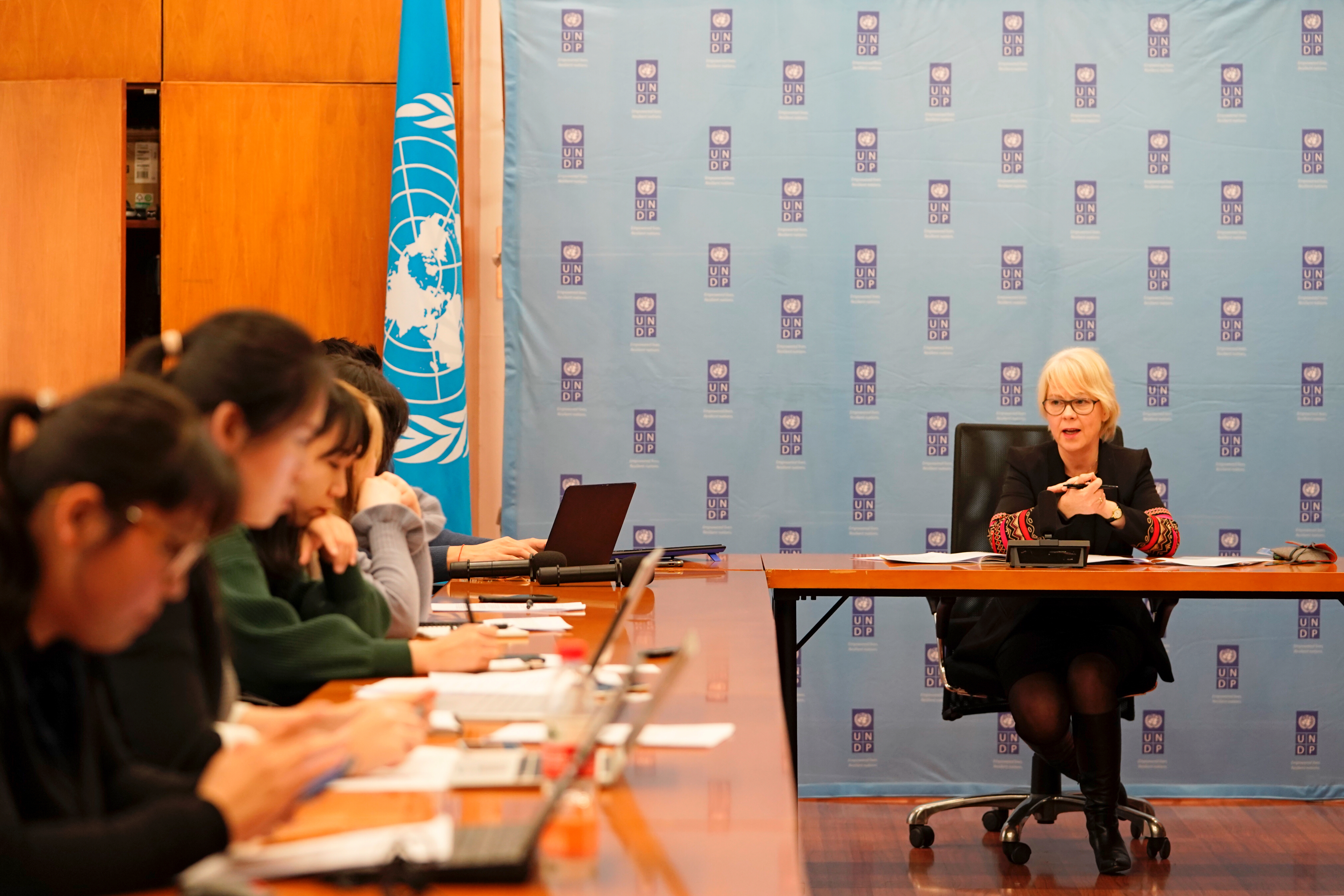UNDP Resident Representative in China Beate Trankmann discussing the 2019 Human Development Report with members of the media
Beijing, December 9, 2019 – The Asia-Pacific region, including China, has witnessed the steepest rise globally in human development. It leads the world in access to broadband internet and is gaining in more developed regions on life expectancy, education, and access to health care. Yet it continues to grapple with widespread multidimensional poverty, and may be vulnerable to a new set of inequalities emerging around higher education and climate resilience.
These are among the key findings of the 2019 Human Development Report, released today by the United Nations Development Programme (UNDP) and entitled “Beyond income, beyond averages, beyond today: inequalities in human development in the 21st Century.”
The Human Development Report (HDR), which pioneers a more rounded way to measure countries’ progress beyond just economic growth, says that as the gap in basic standards is narrowing, with an unprecedented number of people escaping poverty, hunger and disease. the next generation of inequalities is opening up, particularly around technology, education, and the climate crisis.
“This is the new face of inequality,” says UNDP Administrator, Achim Steiner. “And as this Human Development Report sets out, inequality is not beyond solutions.”
The Report analyzes inequality in three steps: beyond income, beyond averages, and beyond today, proposing policy options to tackle it.
Progress along a jagged trajectory
According to the Report’s Human Development Index (HDI), no other region has experienced such rapid human development progress than Asia and the Pacific. South Asia was the fastest growing, followed by East Asia.
In particular, between 1990 and 2018, China’s HDI value increased from 0.501 to 0.758, an increase of 51.1 percent, putting the country in the high human development category.
“China’s development progress over the last three decades has been remarkable”, said Beate Trankmann, UNDP Resident Representative in China. “Since HDI was introduced in 1990, it is the only country in the world to have moved from the low development group to high development category,” she added.
According to the Report, China’s life expectancy at birth has increased from 69 years in 1990 to 76 years in 2018. Expected years of schooling during this period increased from 8.8 years to 13.9. Meanwhile, GNI per capita also increased from 1,530 to 16,127 (in 2011 PPP$).
Beyond these gains in basic standards and capabilities, however, the picture becomes more complex.
Describing the ‘next generation’ of inequalities, the Report notes that in countries with very high human development, subscriptions to fixed broadband are growing 15 times faster and the proportion of adults with tertiary education is growing more than six times faster than in countries with low human development.
The Report states that China leads the world in installed bandwidth, and East Asia is projected to share with North America about 70 percent of the global economic benefits tied to artificial intelligence by 2030.
Although millions throughout the region have escaped multidimensional poverty, the incidence of multidimensional poverty varies enormously across countries. Out of the 1.3 billion multidimensional poor, 661 million are in Asia and the Pacific. Indeed, the Asia-Pacific region’s combined income inequality has risen by over five percentage points in the last 20 years.
In China, the incomes of the bottom 40 percent grew at an impressive 263 percent between 2000 and 2018, which contributed to the fast reduction of extreme poverty. On the other hand, however, according to the report, more than 3% of the country’s population still lives in multidimensional poverty, while an additional 17.1% are vulnerable to the possibility of sliding back into multidimensional poverty.
Despite the fact that on a global scale, more people have access to education than ever before, when it comes to tertiary education, however, the proportion of people having gained access to college and university education over the last 10 years has grown more than six times faster in very high human development countries than in low human development countries.
In fact, only 3.2% of people in low human development countries have a tertiary education compared to almost 30% in high human development countries.
Furthermore, the report warns that the poorest communities remain vulnerable to climate change. Poor people are expected to be more exposed to droughts for warming scenarios above the 1.5°C rise in temperature in several countries in Asia. The rural poor in poor countries are at risk of a double shock: a negative impact on livelihoods and spikes in food prices resulting from drops in global yields.
“Climate change and rising inequalities within countries are two of the major challenges still to be addressed globally,” said Trankmann. “Here in China, drought now affects one sixth of the country’s arable land.”
“SDG 13 – climate action, and SDG 10 – reduced inequality – are critical to achieving the 2030 Agenda and the Sustainable Development Goals,” she emphasized.
Social exclusion, gender bias hinder progress
Based on current trends, it will take 202 years to close the gender gap in economic opportunity alone, cites the report. While the silence on abuse is breaking, the glass ceiling for women to progress is not. Instead, it is a story of bias and backlash. For example, at the very time when progress is meant to be accelerating to reach the Sustainable Development Goals (SDGs) by 2030, the report’s 2019 Gender Inequality Index (GII) says progress actually is slowing.
According to the Report, China has a GII value of 0.163, ranking it 39 out of 162 countries in the 2018 index. In China, 24.9% of parliamentary seats are held by women, slightly higher compared to 24% for the world. In addition, 75.4% of adult women have reached at least a secondary level of education compared to 83.0 percent of their male counterparts.
The Report recommends policies that look at but also go beyond income, including through investments in young children’s learning, health and nutrition. Such investments must continue through a person’s life, when they are in the labour market and after.
The Report also argues that taxation cannot be looked at on its own, but must be part of a system of policies, including policies for public spending on health, education, policies that address inequalities in the market by providing access to capital as well as policies incentivizing alternatives to a carbon-intensive lifestyle.
Looking beyond today, the Report asks how inequality may change in future, particularly through the lens of climate change and technological transformation – two forces that seem set to shape human development outcomes into the next century.
Download the full report here
For more information and media interviews, contact:
Beijing: Yue Zhao, yue.zhao@undp.org, +86 185 1111 0464
Bangkok: Cedric Monteiro; cedric.monteiro@undp.org; +66 92 256 7835
New York: Adam Cathro; adam.cathro@undp.org; +1 212 906 5326 and Anna Ortubia; anna.ortubia@undp.org; +1 212 906 5964

 Locations
Locations

